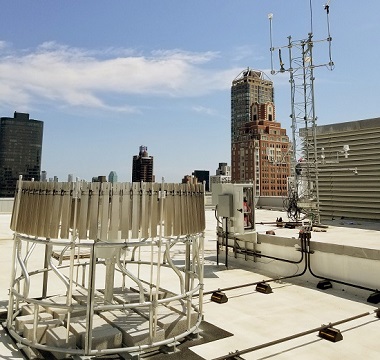UAlbany Researchers Partner to Improve Forecasting, Communication of Extreme Heatwaves in NYC

ALBANY, N.Y. (Sept. 30, 2021) – Although deadly weather conditions are conventionally associated with extreme events such as hurricanes, snowstorms or tornadoes, heatwaves are significantly more deadly on an annual basis, killing an average of more than 600 people in the U.S. per year. That’s more than nearly all other weather events combined.
A new project led by a group of interdisciplinary researchers at the University at Albany, in partnership with the National Oceanic and Atmospheric Administration’s National Weather Service (NOAA NWS) and supported by the NOAA’s Weather Program Office (NOAA WPO), aims to equip New York City with a new set of tools that can be incorporated into decision-making around preparedness and response to extreme heat events.
The project will leverage multiple weather networks, including the NYS Mesonet and NYC Micronet, along with strong collaborations between UAlbany, NWS and New York City Emergency Management (NYC OEM), to enhance the analysis of extreme temperatures in NYC, understand where forecasts may be deficient and improve the communication of extreme temperature hazards for New Yorkers in the metropolitan area.
NOAAWPO is providing $594,105 of funding over the next two years. The project aligns with the Biden administration’s coordinated, interagency effort to respond to extreme heat, which was announced last week.
“Extreme temperatures pose a variety of challenges ranging from increased risk of injury and death, to strains on power grids due to increased air conditioning during heat waves,” said Christopher Thorncroft, director of UAlbany’s Atmospheric Sciences Research Center (ASRC), NYS Mesonet and Center of Excellence in Weather & Climate Analytics (COE). “Forecasting and communicating risks associated with increasingly extreme temperatures is challenging and has motivated us to partner on this collaborative project that will have a direct impact on safety and resiliency for urban New Yorkers.”
"We are excited to partner with UAlbany/NYS Mesonet and New York City Emergency Management to ensure that extreme heat events are communicated in a way that helps New Yorkers become more ready, resilient and responsive," said I. Ross Dickman, meteorologist-in-charge, National Weather Service New York City Forecast Office. "Extreme heat can be detrimental to metropolitan communities, but better-informed heat-mitigation decision-making as a result of this partnership could help save lives."
Extreme Heat Preparedness

With close to 120 faculty, researchers and staff, UAlbany’s Weather-Climate Enterprise hosts the largest concentration of atmospheric, climate and environmental scientists in New York State, and one of the largest in the nation. UAlbany is also home to the nation’s first College of Emergency Preparedness, Homeland Security and Cybersecurity (CEHC).
Together, researchers from the two disciplines are teaming up to create a number of customizable heat-themed tools that can be incorporated into the operations of NWS, NYC OEM and other project partners, such as public utility companies.
Included is an extreme temperature dashboard that publicly displays real-time forecasts for NYC of temperature, heat index, wet bulb globe temperature, and other temperature metrics that are requested by collaborators. The dashboard will be supplemented by a webpage that provides decision-aids for NWS core partners to effectively communicate risk to vulnerable populations.
In addition, the researchers will offer a number of educational outreach opportunities with partners, including a series of webinars, and present their work at the annual meeting of the American Meteorological Society, the Natural Hazards Workshop and the National Weather Association.
“We’re excited to tackle this complex problem. New York City is an especially challenging environment to forecast given the proximity to the ocean, built-up urban environment, and dense population. If we can improve the forecasts, dissemination of information, and ultimately heat-related outcomes, we can make a real difference in people’s lives,” said Nick Bassill, UAlbany meteorologist, director of research and development at the COE, and principal investigator.
“Effectively communicating the risks of extreme heat to decision-makers and to members of the public is key to decreasing adverse health impacts,” said Jeanette Sutton, CEHC associate professor and co-principal investigator. “Our primary research for this project will be conducted in the Emergency and Risk Communication Messaging Lab at CEHC, including web design and usability testing to improve how information is presented and utilized when heat conditions are changing.”
This fall, ETEC, a new $180 million, 245,000 square-foot R&D complex, officially opened on UAlbany’s Uptown Campus. It is the new home of CEHC and UAlbany’s Weather-Climate Enterprise, including the Department of Atmospheric and Environmental Sciences, ASRC, the NYS Mesonet and the COE, along with the National Weather Service’s Albany Weather Forecast Office.
ETEC includes a state-of-the-art decision theater to simulate high-impact weather events, such as heatwaves and an Emergency and Risk Communication Message Testing and Usability Lab.




